Join the Polar research team as we use technology to join Dr. Carin Ashjian this summer as she continues her research in the Arctic! I will be posting Dr. Ashjians journal details of this summer's research expeditions. We first caught up with her onboard the icebreaker U.S.C.G.C. Healy and are now following her onboard the R/V Anika Marie with Captain Bill Kopplin, where she and her team members will continue their Barrow-based research studying the oceanographic conditions of the bowhead whale habitat.
Journal Entry
After a busy few days, we are settled back in Barrow AK. We disembarked from Healy on August 15. After all of our concerns about the transfer by helicopter, we were able to hire a barge that can drive up onto the beach and drop a ramp to transport us and our luggage from Healy to the shore. The process started early, at about 6 AM, when the Healy crew began to wrap plastic around the luggage that we were placing on pallets. At about 8 AM, the barge was pulling up alongside the Healy and tied off and the long gangplank was lowered to the barge. The Healy crane busily moved pallets of duffel bags and coolers containing precious samples to the deck of the barge. After the cargo was on board, it was time for the scientists to troop down the gangplank onto the barge.
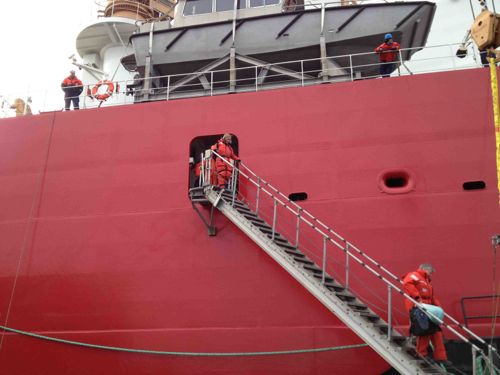
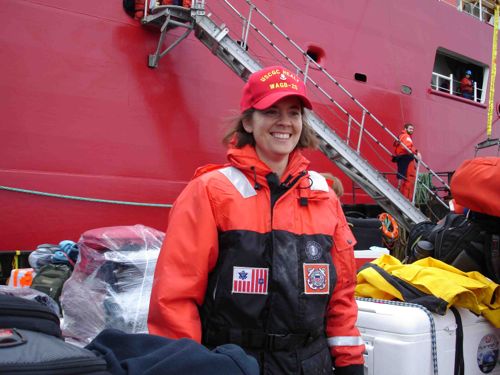
We all donned bright orange Mustang suits and clambered down. From the barge, the side of Healy was a towering red steel wall. Crewmembers faces peered over the side. Captain Reeves oversaw the operation from high up on the ship. As the disembarkation continued, Marine Science Technician Chief Karen Aquino started taking roll, checking off the names of those who had reached the barge. Then, once we were all on board, the gangplank was lifted, the lines were cast off, and we backed away from Healy, turning to head to the gray, coarse sand of the beach in Barrow.
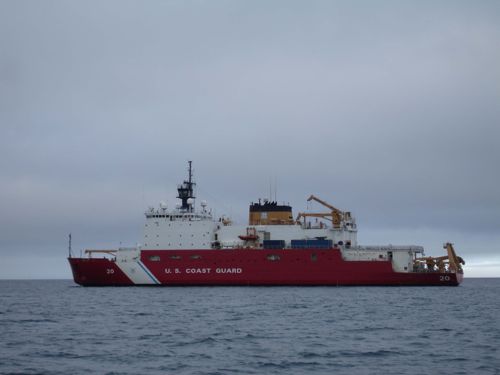
Once we reached shore, we all took off our Mustangs and swarmed onto the beach. Huge fork lifts (actually, front end loaders with forks) lifted the metal trays on which the luggage was stacked and transported them to the beach. Scientists fell upon on the pallets, unwrapping the luggage and coolers. The ongoing science party also was on the beach and hasty hellos and discussions were exchanged. We had been met by a logistics team that had brought some pickup trucks and a stake bed truck on which we piled onto the trucks and brought to a warehouse down the road where scientists identified and collected their gear. Then, we scattered to our separate ways. Some scientists went straight to the airport to try to get on the morning flight. Some went into the logistics office to drink coffee. My group collected our gear and picked up our truck, heading to our lab and our hotel rooms at the old Navy Arctic Research Lab. Strange, to scatter so quickly after being so close.
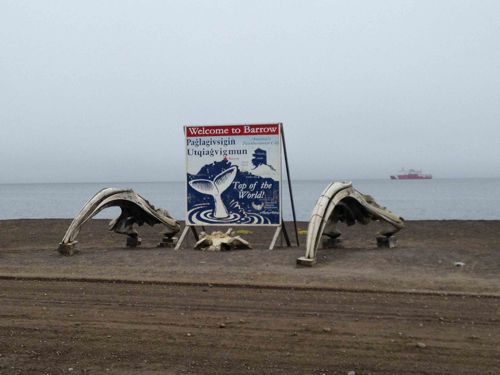
We plunged right into our new reality, the project in Barrow. After re-arranging the furniture in the lab to our satisfaction, we enjoyed our first lunch at the Ilisagvik College cafeteria (yes, for those doubters, it really was good. They had salad. Fresh salad without brown edges. We had run out of salad on Healy). Then we headed over to the storage building to check on our gear that had been shipped to Barrow from Woods Hole at the end of July. Phil, Stephen, and Hangzhou went around the corner to check out the view of the tundra. I opened the building and looked at the gear. Uh oh, there’s a problem. Much less gear was waiting for us than we had sent. We quickly assessed what was present and realized that only two out of five pallets had arrived. The logistics coordinator here contacted Alaska Airlines and then our freight forwarder and discovered that our three pallets had been sitting in Anchorage since August 6 (it was now August 15). There had been so much cargo to go to Barrow that there was a huge backlog. Our freight forwarder work that night and the next day with Alaska Airlines to get the priority on our freight changed and to get the gear shipped to Barrow. All’s well that ends well, the pallets showed up yesterday.
Annika Marie, our research vessel, arrived last night from Prudhoe Bay with Bob, Steve, Captain Bill, and Lars on board.
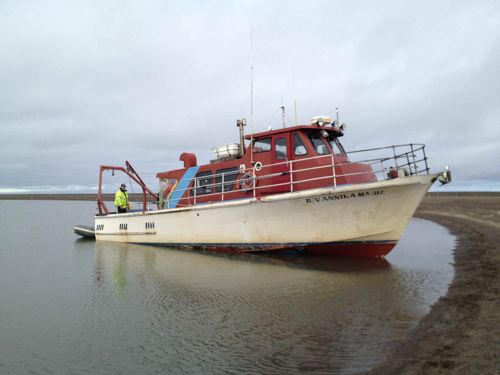
Today we “mob-ed” our gear, bringing it all on board, stringing the wires for the instruments, and testing it all to make sure that everything was working. The afternoon was bright and partly sunny to start but as it progressed, the skies became gray and a wall of fog advanced on us from the north. Rain started to spit out of the sky. The winds started to pick up. It became quite unpleasant on deck. Luckily we were almost finished and have brought the ring nets to attach to the rings in the warmth of the lab. The weather is predicted to be windy tomorrow, likely too windy for us to work. But we are almost ready to go.
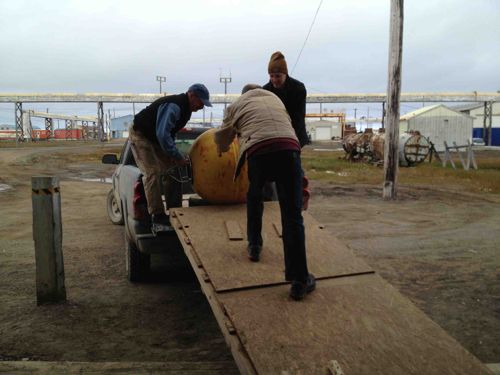
*PolarTREC Journal written by research scientist Dr. Carin Ashjian. Journal and photos posted by Springs School PolarTREC Educator Lisa Seff.


Comments